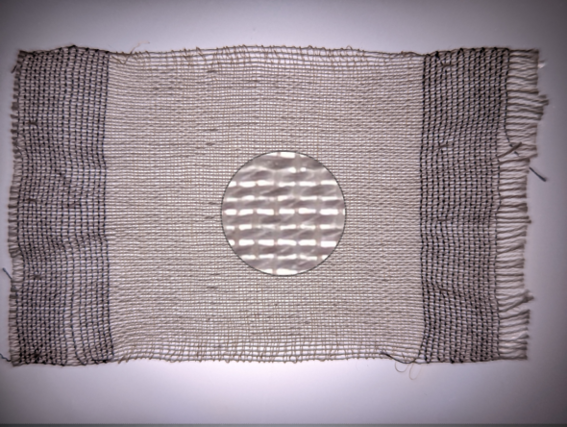New textiles developed at Aalto University change shape when they heat up, giving designers a wide range of new options. In addition to offering adjustable aesthetics, responsive smart fabrics could also help monitor people’s health, improve thermal insulation, and provide new tools for managing room acoustics and interior design.
The new fabrics weave together old technology and a new approach. Liquid crystalline elastomers (LCEs) were developed in the 1980s. LCEs are a smart material that can respond to heat, light, or other stimuli, and they’ve been used as thin films in soft robotics. Although LCEs have been made into fibres, so far they haven’t been made into textiles.
In collaboration with researchers at the University of Cambridge, a team from the Multifunctional Materials Design research group at Aalto, led by Prof. Jaana Vapaavuori, has now used LCE yarns to make woven fabric using conventional textile crafting techniques and tested how they behave.

The team wove LCE yarn in different patterns to make plain fabric, satin, twill, and a weft rib fabric. They made two versions of each pattern using either a soft or stiff LCE yarn, and then they tested how the different fabrics responded to heat from an infrared lamp.
All of the LCE fabrics contracted as they warmed up, though the exact response differed from pattern to pattern. The changes were reversible – the patterns relaxed back to their original shape as their temperature dropped.
‘At first, the impact of using industrial textile techniques with these kinds of new materials wasn’t clear to us. The elasticity of the two types of LCE yarn is comparable to spandex or even softer. That meant it was essential to understand if the textile industry could use these yarns and how the combination with conventional yarns would impact their movement,’ says Pedro Silva, a postdoctoral researcher at Aalto who led the study.

Next, the team combined LCE yarns with linen and nylon in a radial pattern to weave a circle that would lift itself into a cone when heated. Heating the pattern caused the LCE yarn to contract, pulling the cloth up into a cone. As it cooled, the cone relaxed back into a flat circle.
This proof-of-concept brings smart, reactive textiles one step closer to reality. ‘From day one of this project, we took on the challenge of working with experts spanning different disciplines at two institutes. The research succeeded and benefited tremendously from this multidisciplinarity, and now the results are openly available. We hope our work will trigger new ways of thinking when it comes to the materials of tomorrow,’ says Maija Vaara, an AaltoPhD student who crafted the weaves and laces.
The findings were published in Advanced Materials.

Read more news

A new way to measure contagion: the gut bacterium behind blood poisoning can spread like influenza
Neither the antibiotic-resistant nor the highly virulent strains are the most transmissible.
Cross-sectoral working group: Competitiveness, security and green transition must be promoted as a whole
A cross-sectoral working group for universities, businesses and cities is proposing that Finland speed up its international competitiveness, national security and green transition as one entity. The group suggests that, for example, defence procurement could support solutions aimed at a carbon-neutral society.Tonmoy Saha Presents Textile Recycling Research at CIMANET Seminar
The CIMANET Research Seminar, held under the theme “Future Leaders in Circular Materials Bioeconomy,” took place on Thursday, December 4, at the Scandic Marina Congress Center in Helsinki.






